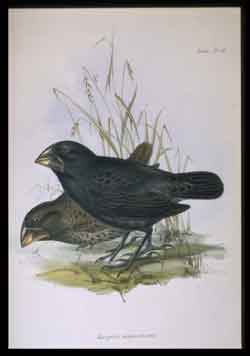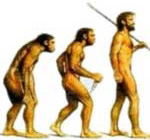One Long Argument, an overview.
|
|
|---|---|
1. Who is DarwinThrough a struggle for existence (populations of individuals and species) over time the variability of a species may give rise to separate species due to geographical or behavioral isolation. He and his cousin, the daughter of Josiah Wedgwood, married and had 10 children three of them died, a daughter (beloved) Annie died of tuberculosis at ten, another daughter at 23 days, and a son Charles who died of Scarlet fever. |
|
1 - 3 , 4, 5, 6, 7- 8, 9, 10, 11
The Context of his life's work:
Barnacle studies were done between the emergence of the theory and his reluctant publication of the book: On the Origin of Species.
Barnacles clearly were a study in how circumstances
defined an animal’s shape, adaptive response to challenging intertidal and marine environments.
1856, began his species book
1859, he had gotten to chapters 9 or 10
June 1859, Wallace’s Manuscript showed up in the mail!
II. Confronting the creationists
Darwin, in 1827, was a devout Episcopalian studying for the ministry – a place suited to naturalists (A Natural History of Selbourne, by Gilbert White)
III. How Species Originate
The problem of speciation since like produces like, with enormous variation in domestic “breeds”
The species book
“This curiously one does not find. Indeed, the longer Darwin struggles with these concepts, the more he seemed to be confused….”
1837 John Gould, the ornithologist tells Darwin he has 3 three not one species of mockingbird from the Galapagos, Darwin knows they are from different islands.
What is a species? Is it more or less, than (isolated, or self selected population of like creatures capable of interbreeding to produce viable offspring) what we see?
There are four main conceptualizations that were common when Darwin approached the problem:
1. Typological, meaning there were natural kinds of groups or classes: quadrupeds.
2. Nominalist, meaning that only individuals exist in reality and that groups are a subjective classification.
3. Evolutionary, meaning that an ancestral population leaves a sequence of descendents to form new populations.
4. Biological, that a coexistent, interbreeding, indigenous population could become reproductively isolated from one another and give rise to new species over time.
Darwin began with a biological approach to species in zoology, but understandably he became confused when looking at botanical specimens. He shifted to a typological approach with plants, and ended with a mixture of "typological and nominalist species definitions."
pp. 29-30.
"Speciation since Darwin, has come to mean the production of new reproductively isolated populations."
p. 31.
IIII. Ideological opposition to Darwin’s five theories
“we mean evolution by means of natural selection.”
V. The Struggle against the physicists and the philosophers.
Earth is too cool (warmth) to be as old as Darwin needs for gradualism to produce the isolation and differentiation he suggests.
Typological thinking replaced by population thinking, “all the world’s a troupe”
VI. Darwin’s Path to the Theory of Natural Selection.
Five facts and three inferences from those facts:
- overpopulation -- Super fecundity
- observation of population’s steady state
- limited
resources (niche partitioning)
- unique individuals (descendents vary)
- inheritance of discrete ranges of variability
- i struggle for existence (survival of the fit, fortunate, fertile)
- ii differential
survival (natural selection)
- iii through many generation the descent with differentiation (evolution)
FIGURE 1, p. 72.
Darwin’s choice of the word ‘selection’ was not particularly fortunate.”
“selects the best. This, of course, is not what natural selection does.” happens
p. 86.
Next
VII. What is Darwinism?
“How Darwinism is seen depends to a large extent on the background of the viewer.”
p. 91.
VIII. A
Hard Look at Soft Inheritance: neo-Darwinism
(Inheritance of acquired traits is soft inheritance)
“Darwin’s major thesis was that evolutionary change is due to the production of variation in a population an the survival and reproductive success (‘selection’) of some of these variants. “
p. 109.
But....”‘the origin of this variation puzzled him all his life.”
Genotype – what the DNA codes for (segregation of inherited traits)
Phenotype-- What the expression of the gamete displays for us to see
(7) Cohesion of the genotype
“there are limits to the independence of different components of the genotype.”
Weismann “he was the only one who understood the overwhelming role of natural selection. And he realized that the source of genetic variation was the great unknown in the process of selection and that a detailed theory of inheritance was the need of the hour.”
p. 130.
IX Geneticists and Naturalists Reach a Consensus:
The Second Darwinian Revolution
 Blending and
soft inheritance (acquired traits) definitely refuted, but the occurrence of
spontaneous mutations was firmly established.”
Blending and
soft inheritance (acquired traits) definitely refuted, but the occurrence of
spontaneous mutations was firmly established.”
“what is selected are whole genotypes, not individual genes,”
“genetic recombination rather than mutation was seen as the immediate source of the genetic variation available for selection.”
133
X New Frontiers in Evolutionary Biology
The impact of molecular biology on evolutionary theory
Bio molecular discoveries.... Have not required a revision of Darwinian theory, but they have provided an understanding of the causes of variability
150
RNA is this the master (diverse and replicable) molecule of change?
DNA memory chips to build proteins & store junk
Proteins long chains that fold and do the work of life
The rest is -- adaptations to the conditions of existence and differential inheritance leading to chance reproductive successes.
me: Siry
Neutral evolution
p. 151.
“the holding capacity of the gene pool”
“it was found that variant genes (alleles) were enormously frequent” more so than “the number of gene changes that have adaptational significance.”
p. 152.
“Perhaps the most disturbing was that organisms do not evolve as harmonious wholes but that different characters (components of the phenotype) and domains of the genotype may evolve at highly different rates.”
p. 159.
Macroevolutionary example “recapitulation” the retention of gill arches in mammalian embryos” for no apparent reason
p. 162.
reductionist and holistic approaches need to be conducted simultaneously in order that
“the connection will be made between the genetics of individuals and populations on the one hand and the major macroevolutionary processes and events on the other.”
p. 162.
NextDarwinism Today
pp. 162-63.
“great emphasis on the development of diversity as an important component of the evolutionary process – his third theory. [See p 2. of these notes]
“realize that evolution is a process involving populations. The only apparent exceptions are the occasional abandonment of sexual reproduction and certain chromosomal processes such a polyploidy.”
“All other speciation is populational, even in the theory of punctuated equilibria.”
p. 163.
Mayr's conception of Darwin's five conceptual revolutions
"spirit of the times" | Darwinian Revolution | Origin of Species | Darwinism | Mayr


